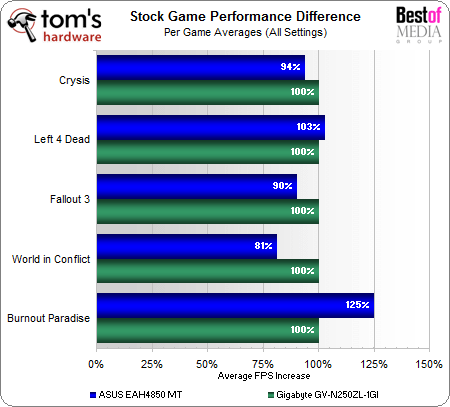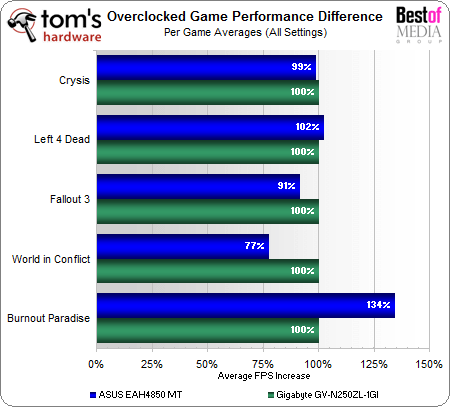Radeon HD 4850 Vs. GeForce GTS 250: Non-Reference Battle
Conclusion
If you skipped over the article to find out if there’s a clear winner between the Asus EAH4850 MT or the Gigabyte GV-N250ZL-1GI, I’m afraid you’re probably going to be disappointed. Both have a great deal of strengths, a few weaknesses, and on average very similar gaming performance.
Let’s start with the Gigabyte’s GV-N250ZL-1GI. It’s an efficient, cool-running, quiet GeForce GTS 250 equipped with a full gigabyte of RAM. While it doesn’t have low-level control over things like voltage, the excellent Zalman VF1050 cooler and Gigabyte’s Ultra Durable VGA feature have proven, at least with our test sample, that it has some real overclocking prowess. Gigabyte’s Gamer HUD Lite overclocking tool is a great, simple utility that gets the job done.
The Asus EAH4850 MT is a similar, but slightly different, kettle of fish. It’s an efficient, quiet Radeon HD 4850 with granular control over all of the card's core functionality. The user can tweak 2D or 3D clock speeds, voltages, and fan settings very easily using Asus' iTracker software. The card even has a passive cooling mode so a user can get the best of both worlds: silent 2D desktop operation and blazing fast 3D overclocked speeds.
Let's look at relative gaming performance across all of our benchmarks:
As you can see, in general, the cards are close. In the majority of titles, the Gigabyte GV-N250ZL-1GI shows a notable advantage, with the Asus EAH4850 MT showing a colossal advantage in a single game title, Burnout Paradise. This one game really slants the average Asus' favor so that the total average performance is extremely close, putting both cards within 1% of one another. Those are the results at stock clock speeds, so let's see if the Asus card's high overclock can gain it some ground over the overclocked Gigabyte card:
Even with both cards overclocked, the landscape remains very similar, with the Asus EAH4850 MT gaining a little ground in most of the titles but losing in World in Conflict.
In summary, performance is strikingly similar across the board with a few exceptions. In the end we'd say the Gigabyte GV-N250ZL-1GI comes out a bit ahead in the games we tested. Conversely, the EAH4850 MT has its own strengths, such as Burnout Paradise with SSAO enable.
Get Tom's Hardware's best news and in-depth reviews, straight to your inbox.
What's interesting is that the overclocked Asus EAH4850 MT, which was set higher than that of the Radeon HD 4870 GPU, didn’t translate into Radeon HD 4870-like results in the game benches. This is a clear indication of how reliant the Radeon HD 4870 is on its huge memory bandwidth, thanks to its fast GDDR5 memory.
At the end of the day, we have only two real nit-picks, and they apply to both of these cards: firstly, the coolers don't channel heated air outside of the case. This isn’t much of a complaint as these cards are designed for silence and GPU cooling first.
However, our second complaint is a bit more devastating: price. both of these cards should be available in the $150 neighborhood, and this brings them within spitting range of the $160 Radeon HD 4870 512 MB, a much faster gaming card. Frankly, these cards should be sitting closer to $140 in order to differentiate them from the garden-variety Radeon HD 4850s and GeForce GTS 250s, while at the same time maintaining some distance from the superior Radeon HD 4870.
We also need to note that when the Asus sample arrived at our door, the EAH4850 MT could be found for about $150 on Newegg with a mail-in rebate from Asus that bought it down to a much more acceptable $140. Curiously, sometime in the last few weeks the Asus EAH4850 MT has since been pulled from Newegg. We hope this is a temporary situation, because it's an impressive implementation of the Radeon HD 4850.
Regardless of pricing politics, these are both excellent products. The Asus EAH4850 Matrix is an overclocker’s dream with easy access to fundamental settings, while the Gigabyte GV-N250ZL-1GI is a quiet, cool, and efficient card with overclocking prowess and a full gigabyte of RAM to boot.
While the GV-N250ZL-1GI takes a slight performance lead in the game benchmarks we used, if you’re a user who wants a quiet system and has a 20” or smaller monitor, either of these products will provide 3D gaming and 2D silence satisfaction.
Current page: Conclusion
Prev Page Power, Temperature, And Noise BenchmarksDon Woligroski was a former senior hardware editor for Tom's Hardware. He has covered a wide range of PC hardware topics, including CPUs, GPUs, system building, and emerging technologies.
-
tuannguyen rags_20In the second picture of the 4850, the card can be seen bent due to the weight.Reply
Hi rags_20 -
Actually, the appearance of the card in that picture is caused by barrel or pincushion distortion of the lens used to take the photo. The card itself isn't bent.
/ Tuan -
jebusv20 demonhorde665... try not to triple post.Reply
looks bad... and eratic. and makes the forums/coments system
more clutered than need be.
ps. your not running the same bench markes as Toms so your not really comparable.
yes, same game and engine, but for example in crysis, the frame rates are completely different from the start, through to the snowey bit at the end.
pps. are you comparing your card to there card at the same resolution? -
alexcuria Hi,Reply
I've been looking for a comparison like this for several weeks. Thank you although it didn't help me too much in my decision. I also missed some comments regarding the Physix, Cuda, DirectX 10 or 10.1 and Havok discussion.
I would be very happy to read a review for the Gainward HD4850 Golden Sample "Goes Like Hell" with the faster GDDR5 memory. If it then CLEARLY takes the lead over the GTS 250 and gets even closer to the HD4870 then my decision will be easy. Less heat, less consumption and almost same performance than a stock 4870. Enough for me.
btw. Resolutions I'm most interested in: 1440x900 and 1650x1080 for 20" monitor.
Thank you -
spanner_razor Under the test setup section the cpu is listed as core 2 duo q6600, should it not be listed as a quad? Feel free to delete this comment if it is wrong or when you fix the erratum.Reply -
KyleSTL Why a Q6600/750i setup? That is certainly less than ideal. A Q9550/P45 or 920/X58 would have been a better choice in my opinion (and may have exhibited a greater difference between the cards).Reply -
B-Unit zipzoomflyhighand no the Q6600 is classified as a C2D. Its two E6600's crammed on one die.Reply
No, its classified as a C2Q. E6600 is classified as C2D. -
KyleSTL ZZFhigh,Reply
Directly from the article on page 11:
Game Benchmarks: Left 4 Dead
Clearly this is not an ideal setup to eliminate the processor from affecting benchmark results of the two cards. Most games are not multithreaded, so the 2.4Ghz clock of the Q6600 will undoubtedly hold back a lot of games since they will not be able to utilize all 4 cores.
Let’s move on to a game where we can crank up the eye candy, even at 1920x1200. At maximum detail, can we see any advantage to either card?
Nothing to see here, though given the results in our original GeForce GTS 250 review, this is likely a result of our Core 2 Quad processor holding back performance.
To all,
Stop triple posting!
-
weakerthans4 ReplyThe default clock speeds for the Gigabyte GV-N250ZL-1GI are 738 MHz on the GPU, 1,836 MHz on the shaders, and 2,200 MHz on the memory. Once again, these are exactly the same as the reference GeForce GTS 250 speeds.
Later in the article you write,or the sake of argument, let’s say most cards can make it to 800 MHz, which is a 62 MHz overclock. So, for Gigabyte’s claim of a 10% overclocking increase, we’ll say that most GV-N250ZL-1GI cards should be able to get to at least 806.2 MHz on the GPU. Hey, let’s round it up to 807 MHz to keep things clean. Did the GV-N250ZL-1GI beat the spread? It sure did. With absolutely no modifications except to raw clock speeds, our sample GV-N250ZL-1GI made it to 815 MHz rock-solid stable. That’s a 20% increase over an "expected" overclock according to our unscientific calculation.
Your math is wrong. A claim of 20% over clock on the GV-N250ZL-1GI would equal 885.6 MHz. 10% of 738MHz = 73.8 MHz. So a 10% overclock would equal 811.8 MHz. 815 MHz is nowhere near 20%. In fact, according to your numbers, the GV-N250ZL-1GI barely lives up to its 10% minimal capability.

